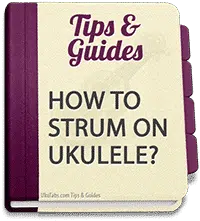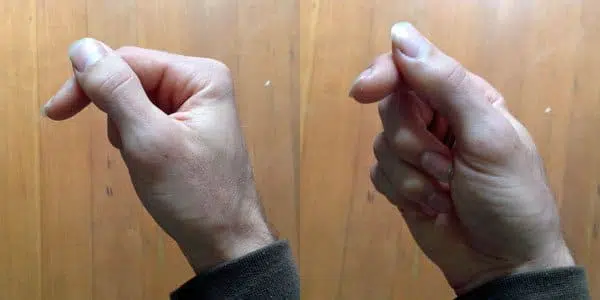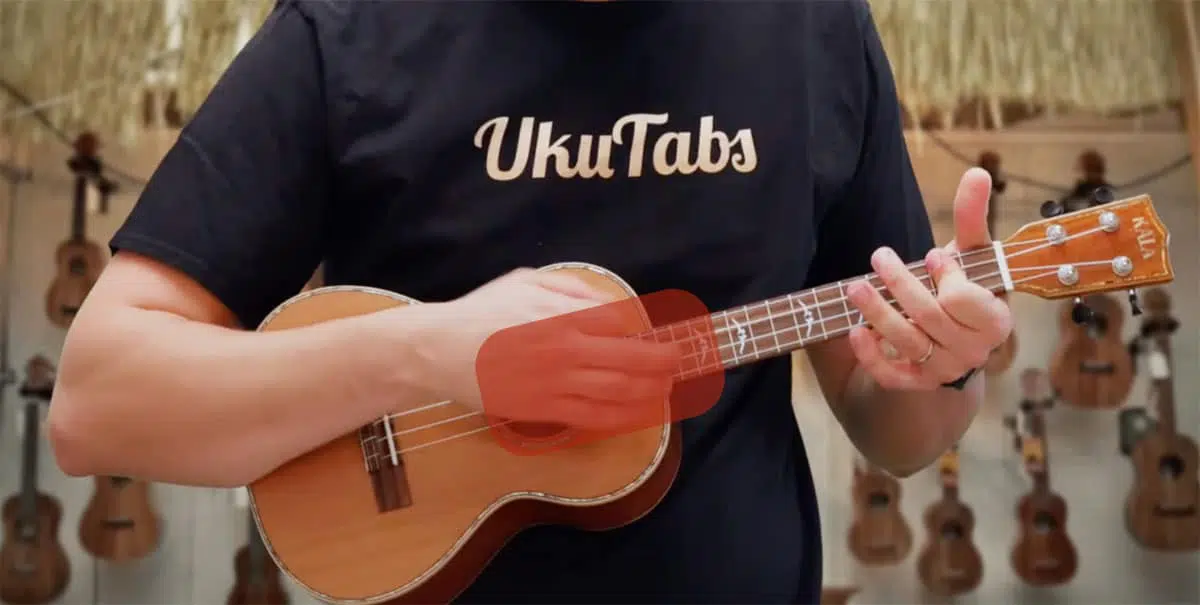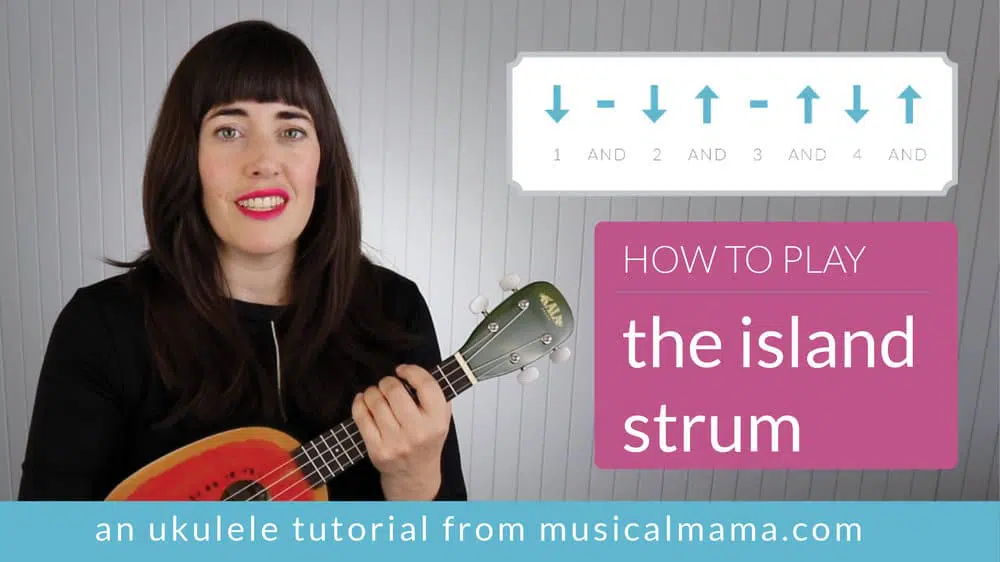Strumming is the most crucial part of playing songs. Learn how to strum ukulele using this guide.
Learn how to strum ukulele
Along with being able to tune your ukulele, knowing the parts of the ukulele, how to read chord diagrams and being able to change quickly between chord shapes, strumming is one of the most essential aspects to achieving that genuine ukulele sound. In the text below, you will learn how to strum your ukulele.
The basics of how to strum your ukulele
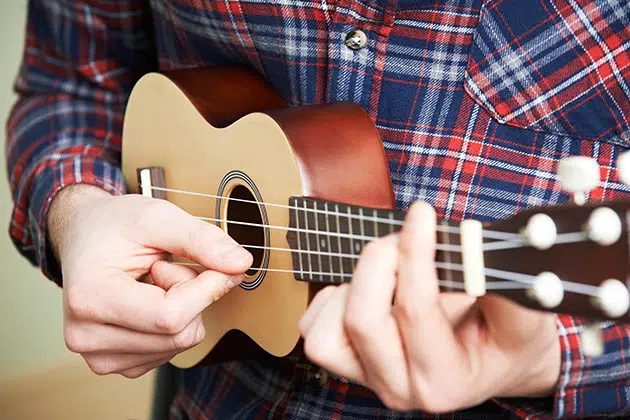
There are several ways to start to learn strumming. Alistair suggests doing it this way:
Start out with the basic hand position, which is a loose fist. Strum with the index finger of your right hand, fingernail side down. When you strum down, you should be hitting the strings with your nail. When you’re strumming up, with the fleshy tip of your finger. It is important to use your wrist rather than your whole hand. Using you whole hand gets tiring very quickly.
When I started playing the ukulele I did it in a different way. I put the tip of my thumb and index finger together as if I were holding a plectrum. I strummed down with the nail of the index finger and strummed up with the tip of thumb. Maybe this is because I had a guitar background, but I found this an easier way to strum in the beginning. You also want to make sure that you strum on the correct spot. Strumming too close to the bridge or too high on the neck will make a dim sound. I’ve found that the best place to strum the ukulele is different on every instrument, but it is around the area where the neck meets the body (see red zone in the image below).
Practice strumming either way by simply going up and down. Once you have mastered this, go on to the advanced section!
Advanced
Welcome to the advanced section! So you’ve mastered the basic up and down strumming. A fundamental aspect of every song is its unique strumming pattern and rhythm, used to create a different sound every time. You can create different strumming patterns by keeping the same up and down motion but not hitting the strings on certain strums. Here’s an example from Al:
“As an example, you could do: down, up, up, down. While doing the constant up, down motion, miss the strings on the up strum, strum down and up, miss the down strum, strum up and down, miss the up strum.”
Strumming Notation
Sometimes you’ll see strumming patterns noted as text. You won’t find any strumming patterns here at UkuTabs because they are not allowed under copyright law. The law doesn’t allow us to explain how to play a specific song here, but you can find the notation for strumming below (from Al).
- d : down strum
- u : up strum
- – : pause or missed strum i.e. moving your hand either up or down but not hitting the strings. This are most useful to give you an indication of the timing of the strums.
- x : indicates a chnk. You strum down and follow through so the underside of your hand lands on the strings, creating a ‘chnk’ sound.
- (d) or (u) : A muted down/up strum. You strum as normal but with your fretting fingers resting on the strings to stop them reverberating. It sounds like a chnk but you can do it with strums in either direction.
- D or U: capitalised letters mean the strum is emphasized (i.e. give it a bit more welly).
Quick tips for how to strum ukulele
1. Make your strumming hand into a loose fist
2. Hold it in front of the centre of your chest
3. Point towards your left boob (or right boob if you’re left-handed)
4. I like to have my thumb steadying my strumming finger. It gives it extra strumming support.
If you strum your ukulele too close to the bridge it sounds very tinny (which might be an effect you want sometimes) and the strings have very little give there. The ‘sweet spot’ (cf. red zone) on the soprano and concert ukes are around the point where the neck hits the body. The sweet spot for tenors is a little closer to the bridge than this.
Moving your arm rapidly up and down gets tiring very quickly. When you strum, use your wrist rather than your whole arm. Whenever you are strumming down, you should be hitting the strings with your nail. When you’re strumming up, you should be hitting them with the fleshy tip of your finger.
Lots of forums for popular uke music use swing time – such as Hawaiian, jazz and blues. In swing time, the down strum lasts twice as long as the up strum (more or less). This makes a simple up-and-down strum sound much more interesting.
You can create some more interesting strumming patterns by keeping the same up-and-down motion but not hitting the strings on certain strums. For example: down, up, up, down. Strum down, miss the strings on the up strum, strum down and up, miss the down strum, strum up and down, miss the up strum.
You can funk up the strumming a little with a few ‘chnks’. With a chnk you strum down and hit the strings with the underside of your hand, so you get a percussive sound from the strum. Sometimes also referenced to as muted strumming.
Dead strums are another way of creating a percussive click from strumming, but this time you’re creating it with your fretting hand. To create them, you stop the strings reverberating by laying your fingers across all the strings.
This is popular and versatile ukulele strum, but it can be a bit of a challenge for beginners. The pattern is as follows (cf. symbols we learned earlier in this guide): d – d u – u d u. This video by Musical Mama shows how it sounds.
Strumming patterns
Al Woodshed from UkuleleHunt has worked out some of the most common strumming patterns and recorded them. A big thank you to him for allowing me to use them. Al also mentioned that the question below is a common question and I have to concur. I’ve had this question quite a lot as well.
What’s the strumming pattern for this?” Unfortunately, there’s no real answer. It’s not like a chord progression where there’s a right chord and a wrong chord. You can use different strumming patterns and it will still work. It’s an important skill to be able to pick your own strumming patterns. Below you can find some of the most common strumming patterns around. Try them out and see if they fit the song.
13 of the most common strumming patterns are listed below, but of course there are a lot more – and you can create unique ones of your own!
4/4 Strumming patterns
By far the most common time signature around is 4/4 (“four four”). If you can count along to a song, “one, two, three, four, one, two, three, four,” and it fits, try out these strumming patterns.
Strumming pattern 1: d – d u – u d –
This one crops up in so many ukulele songs. It’s simple to play. But – because it misses the third down strum – it has a slightly syncopated feel to it which makes it more interesting. Use it in: Charlieissocoollike – A Song About Acne, Outkast – Hey Ya!, Noah and the Whale – Jealous Kind of Love, Zee Avi – Kantoi, Nevershoutnever – Cheatercheaterbestfriendeater, etc.
Strumming pattern 2: d – d u – u d u
Very similar to strumming pattern 1, but with another up strum at the end.
Use it in: Ingrid Michaelson – You and I, Paolo Nutini – High Hopes, I Wanna Be Like You, Misty Miller – Remember, etc.
Strumming pattern 3: d – d – d u d u
Use it in: OK Go – This Too Shall Pass, Keston Cobblers Club – You Go, The Pogues – Fiesta, etc.
Strumming pattern 4: d – d u d u d u
A really straight-forward strum useful for punky stuff. Use it in: UOGB – Teenage Kicks, Ryan Gosling – You Always Hurt the Ones You Love, The Beach Boys – Wouldn’t It Be Nice, etc.
Half-bar patterns
If you’re looking for a strumming pattern for a song where the chords change regularly (twice a bar) try out these.
Strumming pattern 5: d – d u
Use it in: Death Cab for Cutie – I Will Follow You into the Dark, Sesame Street, etc.
Strumming pattern 6: d u x u
Use it in: Hellogoodbye – Betrayed by Bones
Two-bar pattern
If the chords change much more slowly, you could just double up on the 4/4 pattern. Or you could make it more interesting by using a two-bar pattern.
Strumming pattern 7: d – d u – u d u OR – u d u – u d –
Henceforth to be known as the ‘Sophie Madeleine strum’. Use it in: Sophie Madeleine – The Knitting Song & You Are My Favourite & I Just Can’t Stop Myself, Rocky and Balls – Love Cake, Bella Hemming – Play Guitar, Peggy Sue – February Snow, Antarctica Takes It – C&F, etc.
Emphasis
Strumming pattern 8: d u d U d u d U
Use it in: Florence and the Machine – Kiss With a Fist, Sophie Madeleine – Take Your Love With Me, etc.
Strumming pattern 9: d u x u d u x u
Use it in: Nevershoutnever – Biggest Fan, Noah and the Whale – Five Years Time, etc.
Reggae strums
With a reggae strum you’re always going to be accenting the off beats. In the other strums here you’re always playing a strong beat on the ‘one’ of the count. Here you’re accenting other beats. It’s not always obvious what’s going on, so I’ve included a click track with these.
Strumming pattern 10: – d – d – d – d
Here you’re accenting the beats between the count. Use it in: April Smith – Colors, etc.
Strumming pattern 11: – – d u – – d –
Here the accent is on the ‘two’ and ‘four’ beats. Use it in: WIUO – The Israelites, etc.
3/4 Time
If counting, “one, two, three, four,” doesn’t fit with the song you’re playing, try counting in threes instead. If that works, try these patterns.
Strumming pattern 12: d – d u d –
Use it in: Amanda Palmer – In My Mind, John Denver/Ballard C Boyd – Christmas for Cowboys, Weezer – Christmas Song, etc.
Strumming pattern 13: d – d u d u
Use it in: WIUO – Blue Smoke, etc.
Need more input on how to strum ukulele?
I hope this guide has helped you find out more about how to strum your ukulele. Can’t get enough strumming patterns and techniques? I’m a great fan of this “Essential Strums & Strokes for Ukulele” book.
Feel free to contact me whenever you need more information. Keep on practising and enjoy!
Also interested in knowing how to buy the best ukulele strings?
